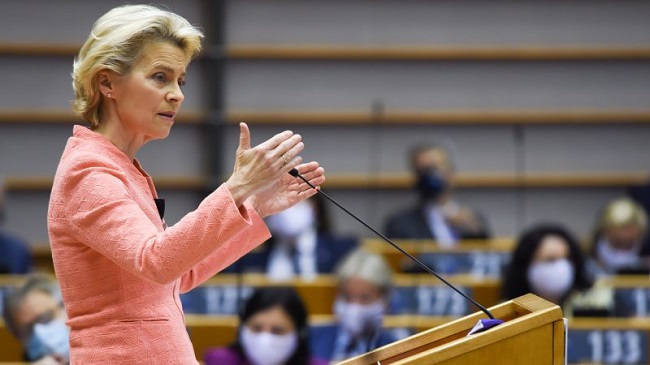EU leaders have agreed to cut carbon emissions by at least 55 per cent by the end of the decade, compared to 1990 levels – a big step up from the current goal.

“Europe is the leader in the fight against climate change,” European Council President Charles Michel tweeted.
“We decided to cut our greenhouse gas emissions of at least 55 per cent by 2030.”
The deal struck by the 27 members of the bloc came after more than 10 hours of negotiations that lasted into Friday, December 11, 2020.
A face-to-face summit between the premiers had started on Thursday afternoon, and sealed decisions on the EU’s long-term budget and recovery fund, the coronavirus, and sanctions against Turkey.
But the climate goals turned out to be the most contentious issue.
The increase from the present 40 per cent reduction target was proposed by the European Commission in September, and encountered resistance in some EU states, like coal-reliant Poland.
Commission President Ursula von der Leyen welcomed the deal.
The new goal “puts us on a clear path towards climate neutrality in 2050,” she said.
But making it reality will require major overhauls in the energy and transport sectors as well as a huge push to renovate buildings.
Huge investments will be required.
One of the main sticking points is how these targets should be set between the member states.
Poland argued that emissions reductions should be relative to a country’s gross domestic product per capita, essentially lowering the targets for lower-income countries, and that it would need more financial support to achieve emissions reductions.
Environmental organisations criticised the new goal.
Nonprofit group Oxfam said the new target “still falls short of what is needed and what is fair.”
“The EU must take urgent practical steps to deliver above and beyond this target,” the organisation said.
Echoing similar sentiments, the Climate Action Network welcomed the agreement but said it didn’t go far enough.
“But given the profound existential threat we are facing, EU leaders cannot allow overly high emissions to continue for another decade and will need to go beyond the agreed target.
“Science is clear that at least 65 per cent emission cuts is the way forward,” Director Wendel Trio said.
So far the EU has cut 22 per cent of its emissions compared to 1990, a recent commission study found.
The European Parliament, which itself is pushing for a slightly higher goal, must still approve the new target.
In a reaction, earth system scientist Johan Rockström, who is Director of the Potsdam Institute for Climate Impact Research, said: “The science is clear; the world needs to reach net-zero emissions by 2050 to stand a chance of holding the Paris limit of keeping global warming well-below 2°C. The EU is the world’s climate leader, and that it commits in the upcoming Climate Law the target of reaching net-zero by 2050 is positive, and will certainly influence countries and actors around the world that either have taken similar steps – like China, Japan and soon the US – or that need to do so.
“The EU pledge of carbon neutrality by 2050 requires large transformative changes, with overall emissions reducing by some 6% per year. This will require large innovations, behavioral change, restructuring sectors and supply chains. Given that evidence increasingly shows that zero-carbon development is beneficial for the economy, jobs, health and resilience, there is a chance that the EU may exceed its own pledges. This will very likely be necessary.”
Also commenting, economist Ottmar Edenhofer, who is Director of the Potsdam Institute for Climate Impact Research, stated: “The European Union is not acting alone, but in line with what recently also the US and China announced. If they all stay true to their pledges, and if others follow, we for the first time have a chance of achieving the Paris Agreement’s climate targets. But that’s a big ‘if’.
“The Paris Agreement clearly did not yet yield sufficiently meaningful nationally determined contributions to climate stabilisation. Still, science has shown a number of possible pathways. Europe, China and the US must now join forces, namely by coordinating CO2 pricing schemes and launching conditionalized financial transfers to poorer countries to enable the global transition towards sustainability. That’s admittedly a bit of a Marathon. So, we should stop tiptoeing and get going.”
